I'm trying to produce an interactive plotly graphic with two vertical axes and on-hover tooltips. The plot should have y1 data as points and y2 data as bars. Everything works just as needed when I use points for data in both sides, but when I use bars for y2 I cannot get the tooltips to display the correct information.
With points at both sides tooltips display fine:
With geom_tile bars at the right side, every bar's tooltip displays the information of all the bars of the same ID:
Some complementary information that could be relevant:
- I'm using
geom_tileto produce the bars because I need to be able to reverse the axes and I was having difficulties doing that with other geoms. I adoptedgeom_tilebased on this SO answer. - It is necessary to produce the plotly graphic from a ggplot one, not directly the plotly one. This is part of a large Shiny app that I got to work on, where the ggplot object is stored apart and further manipulated for other purposes.
MRE
Note: I'm not sure if my example is minimal because I don't know well what part of the process is messing up the tooltips. Thus, I prefer to include all elements of my application case here: two vertical axes, reversing and two different geoms including the problematic bars.
** Data
# for vertical axis y1 (left)
df1 <- data.frame(ID = c("A", "A", "A", "A", "B", "B", "B", "B"),
Date = structure(c(19078, 19085, 19092, 19099, 19078, 19085, 19092, 19099), class = "Date"),
Val = c(236, 221, 187, 136, 77, 100, 128, 180))
# for vertical axis y2 (right)
df2 <- data.frame(ID = c("J", "J", "J", "J", "K", "K", "K", "K"),
Date = structure(c(19078, 19085, 19092, 19099, 19078, 19085, 19092, 19099), class = "Date"),
Val = c(478, 500, 549, 479, 73, 5, 15, 74))
** Working case with points at both sides
library(ggplot2)
library(dplyr)
library(plotly)
# prepare y2 scaled data
ylim1 <- rev(range(df1$Val))
ylim2 <- range(df2$Val)
scale_y2.1 <- function(y, ylim1, ylim2) {
ylim1[1] + (ylim1[2] - ylim1[1]) *(y - ylim2[1])/(ylim2[2] - ylim2[1])
}
dfAll <- full_join(df1, df2, by = c("ID", "Date"), suffix = c("1", "2"))
y2.scl <- scale_y2.1(dfAll$Val2, ylim1, ylim2)
dfAll <- dfAll %>% mutate(Val2_scl = y2.scl)
# prepare y2 ticks and scaled breaks
labs2 <- pretty(ylim2)
brks2 <- scale_y2.1(labs2, ylim1, ylim2)
# generate ggplot
ggp1 <- ggplot(dfAll) +
geom_point(aes(x = Date, y = Val1, color = ID, group = ID), na.rm = TRUE) +
geom_point(aes(x = Date, y = Val2_scl, group = ID, color = ID), na.rm = TRUE, shape = 4, stroke = 0.6) +
scale_y_continuous(trans = "reverse",
sec.axis = dup_axis(breaks = rev(brks2), labels = rev(labs2), name = "Val2")) +
coord_cartesian(ylim = rev(ylim1))
# generate plotly
yaxis2 <- list(overlaying = "y", range = rev(ylim2), ticks = 'outside', side = "right",
title = "Val2", zeroline = FALSE, showgrid = FALSE, automargin = TRUE,
tickfont = list(size = 11.8), titlefont = list(size = 14.6))
ply1 <- ggplotly(ggp1) %>%
add_lines(x = ~Date, y = ~Val2_scl, yaxis = "y2", data = dfAll, inherit = FALSE) %>%
style(showlegend = FALSE) %>%
layout(yaxis2 = yaxis2)
# insert tooltips
tlTips <- paste0("Value: ", c(df1$Val, df2$Val), '\n',
"Date: ", dfAll$Date, '\n',
"ID: ", dfAll$ID)
for (i in seq_along(ply1$x$data)) {
aName <- ply1$x$data[[i]]$name
if (!is.null(aName)) {
aTags <- grep(aName, tlTips, value = TRUE, fixed = TRUE)
ply1$x$data[[i]]$text <- aTags
}
}
# display
ply1
** Broken case with bars at right side
# generate ggplot
ggp2 <- ggplot(dfAll) +
geom_point(aes(x = Date, y = Val1, color = ID, group = ID), na.rm = TRUE) +
geom_tile(aes(x = Date, y = (ylim1[1] + Val2_scl)/2, height = ylim1[1] - Val2_scl, fill = ID, group = ID),
na.rm = TRUE, stat = "identity", position = position_dodge(preserve = "single")) +
scale_y_continuous(trans = "reverse",
sec.axis = dup_axis(breaks = rev(brks2), labels = rev(labs2), name = "Val2")) +
coord_cartesian(ylim = rev(ylim1))
# generate plotly
ply2 <- ggplotly(ggp2) %>%
add_lines(x = ~Date, y = ~Val2_scl, yaxis = "y2", data = dfAll, inherit = FALSE) %>%
style(showlegend = FALSE) %>%
layout(yaxis2 = yaxis2)
# insert tooltips
for (i in seq_along(ply2$x$data)) {
aName <- ply2$x$data[[i]]$name
if (!is.null(aName)) {
t1 <- grepl("(", aName, fixed = TRUE)
t2 <- grepl(",", aName, fixed = TRUE)
t3 <- grepl(")", aName, fixed = TRUE)
if (all(t1, t2, t3)) {
aName <- strsplit(sub("(", "", aName, fixed = TRUE), ",", fixed = TRUE)[[1]][1]
}
aTags <- grep(aName, tlTips, value = TRUE, fixed = TRUE)
ply2$x$data[[i]]$text <- aTags
}
}
# display
ply2




